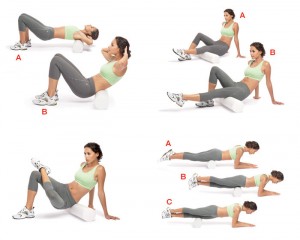A foam roll, or foam roller, is a useful training tool to use as part of your recovery or regeneration plan. Sizes vary, but this cylindrical piece of tightly packed foam is roughly 5 inches in diameter and typically between one and three feet long.
How It Works
Foam rolling uses deep compression to assist roll out muscle adhesions, or knots, that develop over time. Consider your muscle as a shoestring. If it gets in a knot and you pull each ends of the shoestring, the knot gets tighter. You need to work the knot out along with your fingers to revive the initial length of the shoelace. The same goes for muscles. Typically stretching isn’t what you need. By working out those knots in the muscle, which frequently arise from inactivity or repetitive activity, you’ll be able to restore the muscle to its original length, so making it a lot of pliable and functional.
Technique
You can use a foam roll for all your major muscle groups. Glide your body over the foam roll to work each area individually, such as the backs of your legs or your lower back. Pause at any tender points for 10 to 30 seconds before moving on to the next region. Only apply as much pressure as you can tolerate and build up the amount of time you spend foam rolling. Your muscle tissue will begin to get used to this new sensation and be more and more willing to accept the new form of self massage that you’ve implemented into your routine.
Benefits
Foam rolling is like a massage. The compression causes your nerves to relax, loosens muscle, increases blood flow, and helps your body recover. In other words, foam rolling can alleviate soreness and make your muscles feel better.

When to Use It
You can use a foam roll anywhere or anytime. Many people enjoy rolling while watching television or before bedtime. Others do it at the start or end of a training session or after sitting in the same position for hours. Don’t limit yourself to the areas targeted in your training program. Use the foam roll anywhere you feel tight and in need of a massage.
What It Feels Like
You’ll probably enjoy the foam roll routine—everyone likes massages. Still, there’ll be some uncomfortable moments, as there would be during a professional massage. The first time you use a foam roll, it might be a little painful, but that’s just a sign that you stand to benefit greatly from using it. Once you’re past the first few weeks, though, it’ll get considerably easier and more comfortable. The foam roll is a great barometer of the quality of your muscle and connective tissue. The better it feels, and the less it hurts, the higher the quality of your tissue.
Alternatives
In a pinch, you could use a basketball instead of a foam roller. Tennis balls and lacrosse balls are also effective, but foam rolls are better suited for beginners since they’re less dense. The massage stick is a great tool to use in conjunction with a foam roll. For example, you may want to use a massage stick when traveling, or to more closely target tight areas, while using the foam roll at home or in the gym for a general massage all over.










